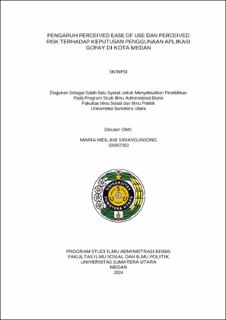Pengaruh Perceived Ease of Use dan Perceived Risk Terhadap Keputusan Penggunaan Aplikasi Gopay di Kota Medan
The Influence of Perceived Ease of Use And Perceived Risk on the Decision To Use the Gopay Application in Medan City.

Date
2024Author
Simangunsong, Maria Meilani
Advisor(s)
Simanjorang, Feronica
Metadata
Show full item recordAbstract
Many users feel that the perceived ease of use of an application is not optimal, especially for Generation X who need clearer guidance in using application features. On the other hand, there are concerns related to perceived risk that affects users' confidence in making transactions, considering the risk of data leakage and digital security is increasingly becoming a major concern. These two factors can potentially influence users' decisions to continue using or switch from the Gopay application.
This study aims to determine the effect of perceived ease of use and perceived risk on using the Gopay application in Medan City. The impact between perceived ease of use and perceived risk will be analyzed partially and simultaneously on the decision to use the Gopay application in Medan City.
The form of research used in this research is quantitative research with an associative approach. The population in this study were users of the Gopay application in Medan City. The number of samples in this study was 96 respondents with sampling techniques using purposive sampling. The primary data used in this study were obtained by distributing questionnaires directly while secondary data were obtained through literature studies. The data analysis methods used are instrument tests, classical assumption tests, multiple linear regression analysis, and hypothesis testing.
The results showed that perceived ease of use and perceived risk have a positive and significant effect both partially and simultaneously on the decision to use the Gopay application in Medan City. The correlation coefficient (R) value is 0.922, which means that there is a relationship between the variable's perceived ease of use (X1) and perceived risk (X2) on usage decisions (Y) of 92.2% so that the relationship between these variables can be categorized as very close. The Adjusted R Square value of 0.846 or the coefficient of determination shows that the variables perceived ease of use (X1) and perceived risk (X2) on usage decisions (Y) are 84.6%, while the remaining 15.4% is influenced by other factors outside this research model.
Collections
- Undergraduate Theses [1455]
